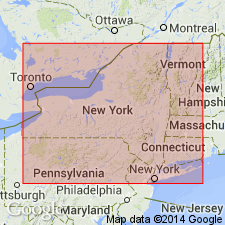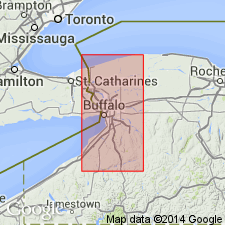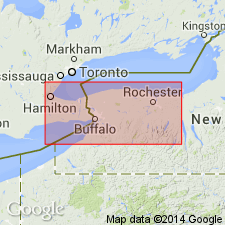
- Usage in publication:
-
- Gothic Hill Limestone Member
- Modifications:
-
- First used
- Dominant lithology:
-
- Limestone
- AAPG geologic province:
-
- Appalachian basin
Summary:
Gasport Limestone of the Lockport Group is divided into a lower Gothic Hill and an upper Pekin Member following the usage of Brett and others (in press: NY State Museum Bull). Gothic Hill Member is described at exposure at Lockport Junction Roadcut and adjacent Gothic Hill Road as exceptionally thick (7 to 8 m) and composed of well to poorly sorted pelmatozoan pack- and grainstones. Brachiopods common in an argillaceous, thin-bedded unit near the top. Age of the Gasport and its two members is Middle Silurian.
Source: GNU records (USGS DDS-6; Reston GNULEX).

- Usage in publication:
-
- Gothic Hill Grainstone Member
- Modifications:
-
- Overview
- AAPG geologic province:
-
- Appalachian basin
Summary:
Lockport Group in this report is considered Late Silurian following Rickard (1975) as the NY Geological Survey does not recognize Middle Silurian as does the USGS. The revisions to the Lockport nomenclature discussed in this report will be formally proposed by C.E. Brett in a larger study of the Niagaran Series. The Lockport Group is divided into the (ascending) Gasport Limestone, the Goat Island Dolomite, the Eramosa Dolomite, and the Guelph Dolomite. The Gasport includes the Gothic Hill and Pekin Members, and the Goat Island includes the Niagara Falls, Ancaster, and Vinemount Members. [Though three of the authors of this report (Tepper, Kappel, and Yager) are USGS scientists, the nomenclature used here has not been officially accepted for use by the USGS.]
Source: GNU records (USGS DDS-6; Reston GNULEX).

- Usage in publication:
-
- Gothic Hill Member*
- Modifications:
-
- Named
- Dominant lithology:
-
- Limestone
- Dolomite
- AAPG geologic province:
-
- Appalachian basin
Summary:
Named the Gothic Hill Member of the Gasport Dolomite for Gothic Hill, near Lockport, Niagara Co., western NY. Consists of thick-bedded to massive, dark-gray to light-pink, dolomitic limestone that weathers light olive-gray. Locally contains small bioherms composed of crinkly weathering, pale-gray to greenish-gray micrite with abundant bryozoans, rugose corals, and pelmatozoan holdfasts. Unit can be divided into three parts: (a) a basal crinoidal- and brachiopod-rich grainstone with dolomicrite clasts near bottom, (b) a middle zone of thinner bedded, more argillaceous, darker gray dolomite with local bioherms, and (c) an upper, coarse grained unit. Thickness is 3 to 21 ft. Unconformably overlies the DeCew Dolomite and conformably underlies the Pekin Member of the Gasport. The transition between the Gothic Hill and Pekin is recognized by changes in color (pinkish to dark-gray or black), grain size (coarse grained to fine grained), and bedding style (thick bedded or massive to thin or medium bedded). The Gothic Hill is of Early Silurian (late Wenlockian) age based on conodonts. [Report uses Early and Late Silurian time scale of Harland and others (1982).]
Source: GNU records (USGS DDS-6; Reston GNULEX).
For more information, please contact Nancy Stamm, Geologic Names Committee Secretary.
Asterisk (*) indicates published by U.S. Geological Survey authors.
"No current usage" (†) implies that a name has been abandoned or has fallen into disuse. Former usage and, if known, replacement name given in parentheses ( ).
Slash (/) indicates name conflicts with nomenclatural guidelines (CSN, 1933; ACSN, 1961, 1970; NACSN, 1983, 2005, 2021). May be explained within brackets ([ ]).

